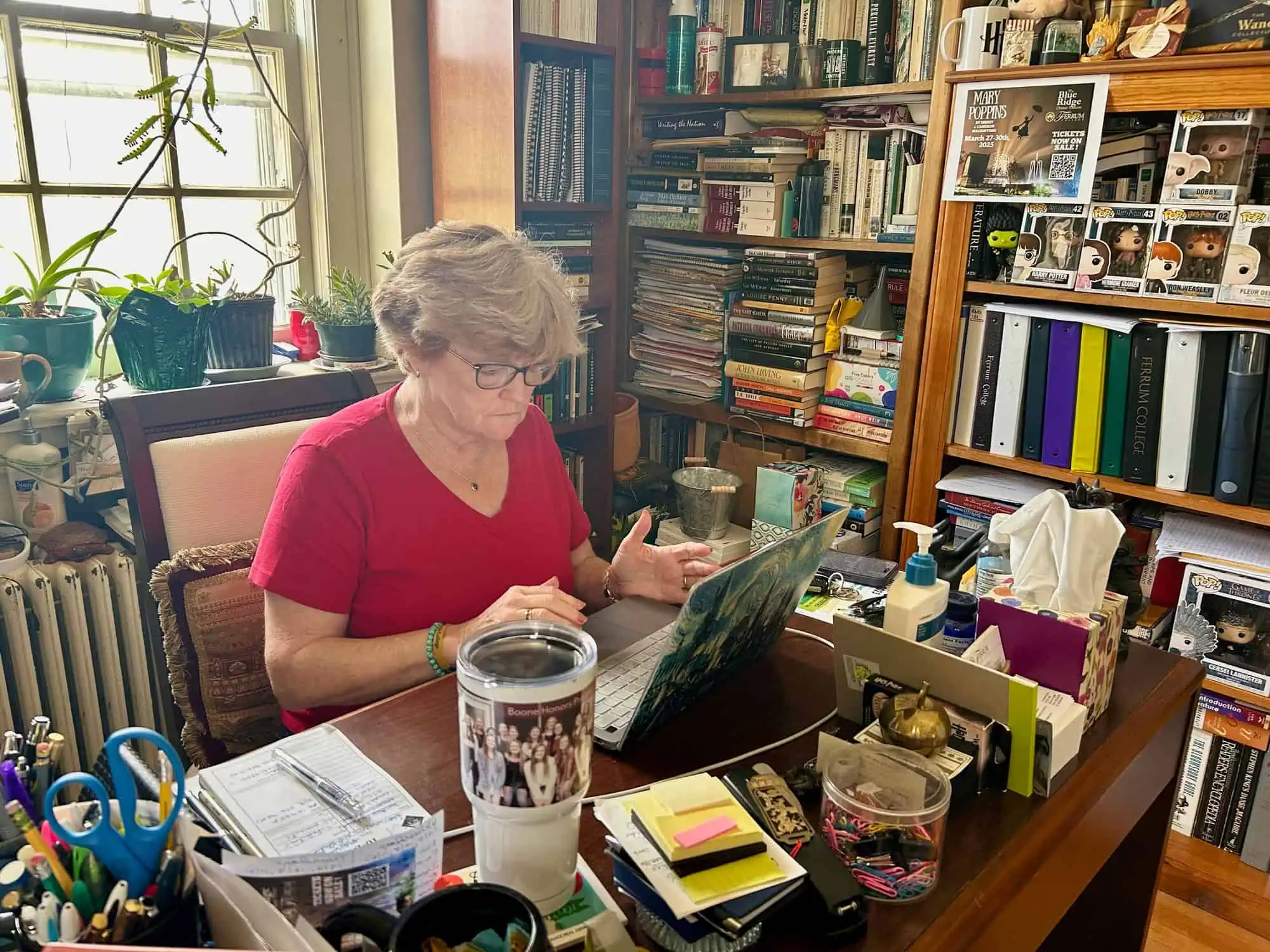
FERRUM, VA, August 29, 2025 – What do political satire, Henry Ford, J. K. Rowling’s Ickabog, absent mothers, and novels about the Underground Railroad have in common? Five faculty members at Ferrum College collaborated to revise book chapters and a conference paper on these topics through a Faculty Writing Collective organized by Professor of English Lana A. Whited. The spring semester project was part of Whited’s work in the Forrest S. Williams Teaching Chair in the Humanities, an academic leadership role that supports faculty scholarship and teaching.
In Perusall, an online social learning platform that some faculty use while teaching classes, the group shared copies of their work in progress and uploaded new drafts as they progressed. Readers wrote comments in the margins and then other group members could respond. Comments ranged from small proofreading tips and praise for the colleagues’ research and writing to recommendations about other resources and chatty digressions about amusing or intriguing links between these topics and other ideas. The group also met in person three times to enjoy refreshments and discuss the progress of each writing project.
Professor of English Tina L. Hanlon wrote a new paper that she presented on June 11 at the Children’s Literature Association’s annual conference, in a session on Fantasy, Gothic, and Time-Slip Fiction. It was her 25th time to participate in this conference in different locations since 1994, and it was held virtually this year. Hanlon’s paper, “Time and Rememory: History of the Underground Railroad in The House of Dies Drear,” analyzes a young adult novel by Virginia Hamilton and its sequel. After it was published in 1968, the novel won an Edgar Allan Poe Award for mystery writing.
Set around Hamilton’s hometown of Yellow Springs, Ohio (near Hanlon’s own Ohio birthplace), the books depict a modern boy moving to a historic house that appears to be haunted because of its violent past. Hanlon’s slides include maps showing Ohio’s vast network of stops on the Underground Railroad. Rather than using supernatural elements or time travel, however, Hamilton incorporated local superstitions and the traditions of adventure stories to send the boy on a journey through time that stays in the real world of the Underground Railroad’s history and contemporary race relations.
Hanlon will share her presentation on Hamilton’s novels and the Underground Railroad with the African American Literature course in fall semester, which is taught by Professor Emeritus Melvin Macklin.
Dr. Ed Hally, associate professor and program coordinator of political science and public administration, workshopped the proposal and sixth chapter of his book on political satire. His working title is Bleeding Age Wit: Political Satire in the Era of Trump. Hally explores the educational value of satire as it “bypasses the central mode of cognitive processing and influences viewers on a more intuitive, emotional level.” He also discusses recent challenges of satire in relation to misinformation, the rise of satire from the alt-right, and the expansion of satire’s consumer base, with younger viewers experiencing it through newer media forms. His book is intended for classroom use as well as general readers interested in politics, current affairs, or the mass media. Hally said he received helpful suggestions from his colleagues about submitting his book manuscript to publishers.
Dr. Nicole Greer Golda, a former history professor at Ferrum College, submitted the introduction and sixth chapter of her book The Detroit Model: Family Order, Migration, and the Making of the American Industrial City. It describes the role and widespread influence of Henry Ford and Ford Motor Company in the enculturation and socialization of a major American city. She expects the book to be published in 2026 by the University of North Carolina Press in its Gender and American Culture series.
Professor of English Katherine Grimes, program coordinator of English, worked on a long-term project converting her doctoral dissertation to a book for publication. Entitled The Motherless Child: The Absent Mother in Twentieth-Century Southern Literature, her research explores the impact of motherlessness on white authors, for whom the absence of the maternal figure represents the loss of the Old South, and African American authors, for whom the mother’s absence represents the loss of the motherland, Africa. The group gave Grimes suggestions for shaping the scope of her project and adding twenty-first-century books.
Whited, who has written extensively about J. K. Rowling’s work and edited three books about the Harry Potter series, wrote the first draft of a book chapter that was due in July for the anthology Potions, Powers, and Prejudice: Reassessing Harry Potter. It will be published in 2026 by Litwin Press. Whited’s chapter discusses contradictions between J. K. Rowling’s well-known public statements about transgender individuals and her nuanced, sympathetic presentation of a gender-fluid title creature in her 2020 novel The Ickabog. The book-length fairy tale was released at the time of greatest controversy and damage to Rowling’s reputation, most involving her Twitter posts. Whited’s chapter analyzes how an author can create fictional characters and scenarios that seem at odds with the author’s own publicly stated views, and the significance of this disconnect.
Whited said, “The Faculty Writing Collective was a productive endeavor for all participants, involving scholarship that will benefit others in our disciplines and bring credit to our college. I hope it will be possible to repeat this opportunity for faculty in the future.”
“This faculty writing collective is a beautiful reflection of the talent, passion, and scholarly depth that live within the heart of Ferrum College,” said President Mirta Martin. “I am so grateful for our faculty, who not only committed themselves to their own intellectual pursuits, but also lifted one another through collaboration and shared purpose. Their work reminds us that Ferrum College is not just a place of learning; it is a community of thinkers, creators, and changemakers who are transforming the world beyond our campus.”
About the photograph: Dr. Lana Whited writing at her desk in Britt Hall.